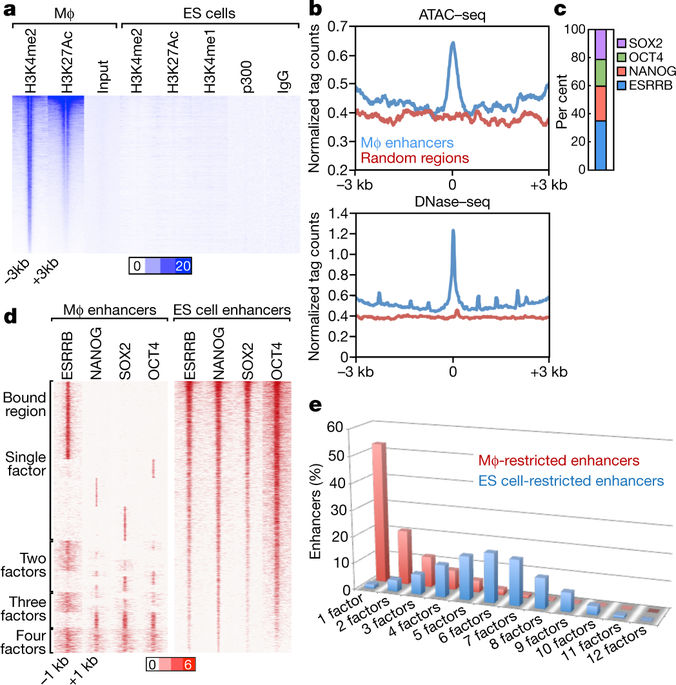Our official English website, www.x-mol.net, welcomes your
feedback! (Note: you will need to create a separate account there.)
Pluripotency factors functionally premark cell-type-restricted enhancers in ES cells
Nature ( IF 50.5 ) Pub Date : 2018-04-01 , DOI: 10.1038/s41586-018-0048-8 Hong Sook Kim 1 , Yuliang Tan 1 , Wubin Ma 1 , Daria Merkurjev 1 , Eugin Destici 1 , Qi Ma 1 , Tom Suter 1 , Kenneth Ohgi 1 , Meyer Friedman 1 , Dorota Skowronska-Krawczyk 1, 2 , Michael G Rosenfeld 1
Nature ( IF 50.5 ) Pub Date : 2018-04-01 , DOI: 10.1038/s41586-018-0048-8 Hong Sook Kim 1 , Yuliang Tan 1 , Wubin Ma 1 , Daria Merkurjev 1 , Eugin Destici 1 , Qi Ma 1 , Tom Suter 1 , Kenneth Ohgi 1 , Meyer Friedman 1 , Dorota Skowronska-Krawczyk 1, 2 , Michael G Rosenfeld 1
Affiliation

|
Enhancers for embryonic stem (ES) cell-expressed genes and lineage-determining factors are characterized by conventional marks of enhancer activation in ES cells1–3, but it remains unclear whether enhancers destined to regulate cell-type-restricted transcription units might also have distinct signatures in ES cells. Here we show that cell-type-restricted enhancers are ‘premarked’ and activated as transcription units by the binding of one or two ES cell transcription factors, although they do not exhibit traditional enhancer epigenetic marks in ES cells, thus uncovering the initial temporal origins of cell-type-restricted enhancers. This premarking is required for future cell-type-restricted enhancer activity in the differentiated cells, with the strength of the ES cell signature being functionally important for the subsequent robustness of cell-type-restricted enhancer activation. We have experimentally validated this model in macrophage-restricted enhancers and neural precursor cell (NPC)-restricted enhancers using ES cell-derived macrophages or NPCs, edited to contain specific ES cell transcription factor motif deletions. DNA hydroxyl-methylation of enhancers in ES cells, determined by ES cell transcription factors, may serve as a potential molecular memory for subsequent enhancer activation in mature macrophages. These findings suggest that the massive repertoire of cell-type-restricted enhancers are essentially hierarchically and obligatorily premarked by binding of a defining ES cell transcription factor in ES cells, dictating the robustness of enhancer activation in mature cells.Binding of an embryonic stem in two cases cell-specific transcription factor pre-marks cell-type-restricted enhancers in embryonic stem in two cases cells, and this premarking is required for the robustness of enhancer activation in differentiated cells.
中文翻译:

多能性因子在功能上预先标记 ES 细胞中的细胞类型限制增强子
胚胎干 (ES) 细胞表达基因和谱系决定因子的增强子以 ES 细胞中增强子激活的常规标记为特征1-3,但尚不清楚旨在调节细胞类型限制性转录单位的增强子是否也可能具有不同的ES 细胞中的特征。在这里,我们表明细胞类型限制的增强子被“预先标记”并通过一个或两个 ES 细胞转录因子的结合被激活为转录单位,尽管它们在 ES 细胞中没有表现出传统的增强子表观遗传标记,从而揭示了最初的时间起源细胞类型限制性增强剂。这种预先标记是分化细胞中未来细胞类型限制的增强子活性所必需的,ES细胞特征的强度对于随后的细胞类型限制增强子激活的稳健性在功能上很重要。我们已经使用 ES 细胞衍生的巨噬细胞或 NPC 在巨噬细胞限制性增强子和神经前体细胞 (NPC) 限制性增强子中通过实验验证了该模型,经过编辑以包含特定的 ES 细胞转录因子基序缺失。ES 细胞中增强子的 DNA 羟甲基化由 ES 细胞转录因子决定,可作为成熟巨噬细胞后续增强子激活的潜在分子记忆。这些发现表明,细胞类型限制性增强子的大量库本质上是通过与 ES 细胞中定义的 ES 细胞转录因子结合而分层和强制地预先标记的,
更新日期:2018-04-01
中文翻译:

多能性因子在功能上预先标记 ES 细胞中的细胞类型限制增强子
胚胎干 (ES) 细胞表达基因和谱系决定因子的增强子以 ES 细胞中增强子激活的常规标记为特征1-3,但尚不清楚旨在调节细胞类型限制性转录单位的增强子是否也可能具有不同的ES 细胞中的特征。在这里,我们表明细胞类型限制的增强子被“预先标记”并通过一个或两个 ES 细胞转录因子的结合被激活为转录单位,尽管它们在 ES 细胞中没有表现出传统的增强子表观遗传标记,从而揭示了最初的时间起源细胞类型限制性增强剂。这种预先标记是分化细胞中未来细胞类型限制的增强子活性所必需的,ES细胞特征的强度对于随后的细胞类型限制增强子激活的稳健性在功能上很重要。我们已经使用 ES 细胞衍生的巨噬细胞或 NPC 在巨噬细胞限制性增强子和神经前体细胞 (NPC) 限制性增强子中通过实验验证了该模型,经过编辑以包含特定的 ES 细胞转录因子基序缺失。ES 细胞中增强子的 DNA 羟甲基化由 ES 细胞转录因子决定,可作为成熟巨噬细胞后续增强子激活的潜在分子记忆。这些发现表明,细胞类型限制性增强子的大量库本质上是通过与 ES 细胞中定义的 ES 细胞转录因子结合而分层和强制地预先标记的,











































 京公网安备 11010802027423号
京公网安备 11010802027423号